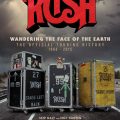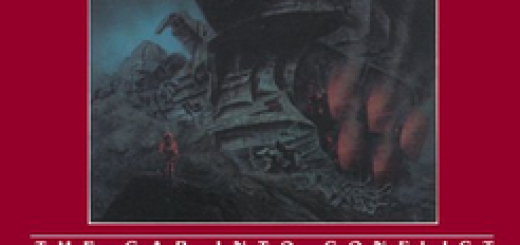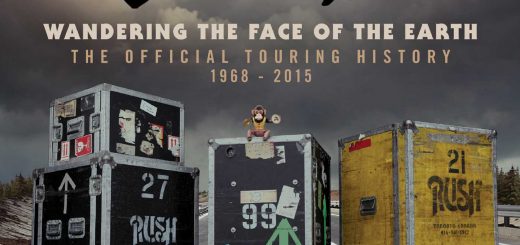book notes: Far and Away by Neil Peart
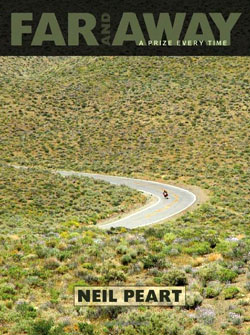
As my wife found out when I took her to her first Rush concert many years ago, Rush fans are an enthusiastic group (to put it mildly). She was amused to watch me and several of my newly-met-friends singing every word, every lyric of their songs. These lyrics were, of course, written by the world’s greatest drummer Neil Peart. I am a large Rush fan (as can be seen by some of the articles here). I’ve always enjoyed not only the music, but many of Neil Peart’s lyrics. I’ve previously read his Clockwork Angels collaboration with Kevin J. Anderson (reviewed here at the Hugo-award winning blog SFSignal) and his Roadshow book. Neil’s series of three travelogue/journal books have been on my want-to-read list for quite some time, and, thanks to a gift from my daughter, they are now in my collection. Published in 2001, the first in the series is Far and Away by Neil Peart, subtitled A Prize Every Time.
If the reader is not a Rush fan (rumor has it that there are some), they might think that this book is not for them. But I would (and have) recommend this book to motorcycle enthusiasts, travel book lovers, memoir readers, and of course, musicians. It is an interesting, entertaining, informative and at times heart-wrenching set of stories written by one of the best drummers in the world – who views himself as just a working man, trying to get better, at drumming, at life…just trying to earn the love and respect of those around him.
In her book The Art of Memoir by Mary Karr, there is a chapter entitled “A Voice Conjures the Human Who Utters It“.
Each voice is cleverly fashioned to highlight a writer’s individual talent or way of viewing the world.
…..
Pretty much all of the great memoirists I’ve met sound on the page like they do in person.
Pages 33-34, from The Art of Memoir by Mary Karr
If you’ve watched any of the Rush documentaries and heard Neil speak, then read these books of his, the voice in my head sounds like his voice. There are certainly times when these stories ramble, but many memoirs to – as the journey is the main point.
I thought some of these article might be from the official Neil Peart website (which is still up) – but the oldest “news” article up there is from 2012. Perhaps they are in one of the later books in this series – I will see when I get there.
The entries in these books are chronological by month and year. As I just went through the RUSH touring history book, I’m going to see if I can match up where they were on tour with those time stamps. This first set is on the Snakes and Arrows tour. For a little extra timeline and perspective, I’ve also entered Neil’s age along the way. He wrote these when he was in his fifties, as I am currently (at least for nine more months!), and I find I identify with many of his viewpoints and philosophy. I’ve pulled out favorite quotes and sections.
Intro – A Prize Every Time
There are many articles of my own on this blog that try to put travels and experiences into words. Reading one of the first paragraphs in this first book in this series showed me I was going to learn a lot from another author with similar intents.
The old-time serialized novel occurred to me as one way to describe the nature of these stories – a serialized autobiography, perhaps, though not recollected in one’s dusty old age, but captured along the way. By design, these stories are not an attempt to list the facts and incidents of my life, like diary entries. My inspiration always comes from the world around me, driven by the recurring thought “How can I put this into words?” I am more interested in describing what I do and see, how it makes me feel, and sharing it with the reader – almost like a personal letter, with more time spent on the craft. So it’s a book of letters, and a serial memoir, and a travel book that includes motorcycling, drumming, snow shoeing, cross-country skiing, natural history, human history, birdwatching, hiking, driving, church signs, amateur philosophy and … pretty much everything.
pg ix – x, Far and Away by Neil Peart
1. That’s the Way We Roll (July 2007)
From the book RUSH: Wandering the Face of the Earth, this is the description of the Snakes and Arrows tour:
The trek, consisting of sixty-four shows, took the band across the US and Canada before ending with a run through Europe, including the UK and Scandinavia. The outing was the twenty-fifth highest grossing North American tour of 2007 according to Billboard magazine, netting $29.6 million in Ticket sales (attendance was 517,211 out of a 720,497 capacity over forty-eight shows).
From RUSH: Wandering the Face of the Earth, page 378
This part of the Snakes and Arrows tour went from June 2007 to October 2007, and is covered here in chapters 1, 2 and 3.
Neil talks about writing this article after “the first leg of the Snakes and Arrows tour (sixteen shows, 7,257 miles of motorcycling)”.
Despite my usual apprehension before embarking on another long concert tour, I have been enjoying this one so far. Each show is a little shorter this time and doesn’t drain me quite so much, so I have a little energy left over to enjoy life offstage. We’re also having a few more days off this time, because Geddy found that last tour’s schedule, where we often had pairs of shows with a single day off between them, was too hard on his voice. So we’re playing fewer shows per week, and though the remain tiring, of course, they’re not quite so draining.
page 5, Far and Away by Neil Peart
2. Every Road Has Its Toll (August 2007)
There’s a description in this chapter on Neil hitting a deer – every motorcyclist’s nightmare. Luckily for Neil it just grazed his front tire; unluckily for the deer, it was injured and hurting and Michael, Neil’s riding partner, had to put it down.
(I am glad to report that rural Texas continues to boast the most courteous drivers in the country, perhaps in the world. When you come up behind a pickup or sedan on a two-lane backroad, they not only move over willingly, right onto the shoulder, but wave you by cheerfully.)
page 12
Living in the great state of Texas, I would agree. Driving in Texas’ big cities, however, is a completely different prospect; we certainly have more than our fair share of rude city drivers! My wife is convinced that drivers hit their horns in Austin frequently just to make sure they are still working.
In the chapters when they are on tour, interspersed with the motorcycle touring descriptions are little vignettes about the music and particular concerts.
Many friends have commented to me how well Geddy is singing, and it’s true – I’ve listened to a few recorded shows on the days off, and his voice sounds unbelievably good. (It’s a simple stark fact illuminating the importance of that voice that if he couldn’t do it anymore, we couldn’t do it any more.) Plus, as I said to Geddy after listening to one of the shows, “You’re not just performing – you’re really singing out.”
page 11
This mirrors what I have read that Geddy and Alex have said now that Neil has passed – there is no Rush without the three of them together.
3. Shunpikin’ It Old Skool (September 2007)
On September 12 of 2007, Neil Peart turned 55.
The provided definition of “shunpikin” is – shunning the turn pikes. For Neil and Michael, it means driving the small roads, the ones marked with thin grey lines on the maps.
On this trip they plot a course and visit Nauvoo, Illinois, where there is a reconstructed Mormon temple. It is built on the same site as the original from 1846.
Well, because that’s what we do – we explore strange new worlds and alien civilizations. (Michael actually made that comparison later that same day, at our motel in Burlington, Iowa, thinking back over some of the pockets of eccentric Americana we had been traveling through. He thought I would be Captain Kirk and he would be Spock, but I’m not sure about that.)
page 26
4. Haste Ye Back (November 2007)
The band heads to Scotland, to start the European part of the Snakes and Arrows tour where he sees (of course) a sign with the words that are this chapter’s title.
They eventually follow the tour to the European continent. Neil goes by a fascinating World War I memorial to Canadian soldiers, where France deeded the land to Canada – a Canadian National Park on foreign soil. It is called the Vimy Ridge National Historic Site of Canada. This is “fascinating” to me at least, as my grandfather went to France in World War I.
They also bike to several of Mad King Ludwig’s castles in Bavaria (which I got to take my family to thanks to several trips to Munich while working for Compaq!) and through the Black Forest.
5. The Hour of Arriving (December 2007)
The European tour and bike ride continues in this chapter. “The Hour of Arriving” is Neil’s description of arriving – both to a well-chosen hotel or to the venue where Rush will be performing after a nice long ride. He describes both as rituals, habits that are enjoyed and/or necessary.
Perhaps my favorite part of a long day on the motorcycle is that first hour of arriving and settling into a hotel, whether humble or luxurious. It feels so good to pull up in front of the hotel, kick down the sidestand, and lift a weary leg over the saddle, still keyed up from the day’s adventures, yer gradually easing into a more relaxed state of mind.
page 42
He goes on to describe this ritual, including pulling out the flask of The Macallan. This is in contrast to show days.
On a show day, the hour of arriving is completely different. It is not the end of the day’s labors, but merely the beginning. Not least, there is still a three-hour show to perform. Soundcheck at 5:00 is the first “scheduled activity,” but there is always plenty to do before that. We like to arrive between two and three…”
page 48
6. The Best February Ever (March 2008)
There are a few chapters in this tome that do not involve motorcycle riding and they are a welcomed diversion. This chapter focuses on Neil’s love of snowshoeing and cross-country skiing around Quebec.
For one thing, I believe no sport is more beautiful than cross-country skiing. The only possible comparison might be wilderness hiking. Long distance cycling and running, for example, must usually be done in less picturesque surroundings – public roads in most cases – and endurance swimming is too often confined to counting laps in an indoor pool. But the snowy woods, and the trails through them, are always pretty.
Pg 55
I would normally argue and say that trail running is just as beautiful…but I’m not sure if you have to look at your feet as much in cross-country skiing as you do in trail running (not much snow down here in Texas – though I have snow-shoed in Colorado a couple of times!). When I ran the Pikes Peak Ascent, it was some of the most beautiful scenery I’ve seen anywhere – until I couldn’t breathe in the high altitude and had to watch my feet!
7. South by Southwest (May 2008)
These next chapters coincide with the next part of the Snakes and Arrows tour, called the “Snakes and Arrows Live” tour in RUSH: Wandering the Face of the Earth (cause there was a live album, ya know). This tour with from April 2008 to July 2008, and is covered in Chapters 7, 8, and 9.
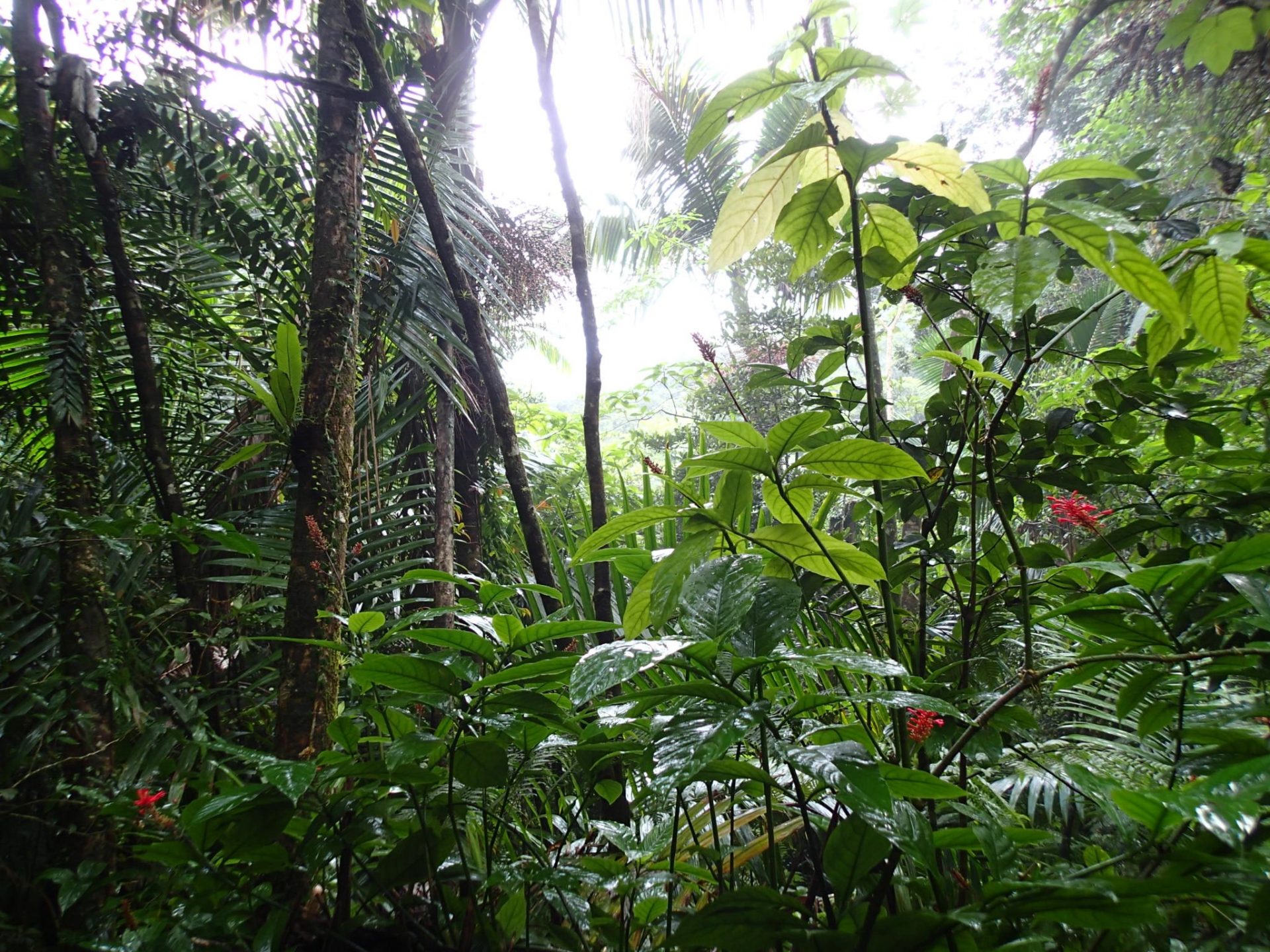
During these rides and tours there is a trip to Puerto Rico, to coincide with the first stop on this tour in San Juan on April 11, 2008. Neil rides through El Yunque National Forest, where my family and I visited a few years ago. A photo I took shown here goes well with his descriptions.
Riding through the dense greenery in El Yunque National Forest, on our first ride in Puerto Rico, I was struck by the seemingly numberless variety of plants and trees, from fears and cycads (the oldest plant form on east – dinosaur food) to bananas, palms and bamboo, delicate little blossoms on the roadside, velvety oases, and a mosaic of interlocking leaves overhead.
It might almost be said that Hawaii’s relatively limited palette of greenery suggests a creationist simplicity, a pristine Eden, while Puerto Rico, collecting from North America, South America, and even the ancient supercontinent of Pangea, overflows with a complex hurly-burly of evolutionary struggle and burgeoning life.
pages 64-65
8. When the Road Ends (June 2008)
This chapter starts with a photo of a road completely blocked with snow near Mount Saint Helens on the way to a gig near Portland. There are lots of roads that have been blocked during Neil’s travels. But the last part of this chapter, which describes a recurring theme in a lot of these stories, says it all.
When I ride the open roads, from time to time I have given a little thought to trying to write another book. It seems to me that the stories i’ve been writing for this website are laying a good foundation for another challenge I might like to undertake: a book called Roadcraft: How to Work the World. If I could draw together all I’ve learned about traveling in the literal sense and in a larger, metaphorical way, it might be worthwhile. It wouldn’t be just for motorcyclists, of course, or even just for travelers – but I would love to make the particular elements of roadcraft apply to the larger journey: life.
The gas can, the oil changes, the rain gear, the maps and signs.
How to make the most of the road you’re on; what to do when the road gets tough; what to do when the road ends.
That would be a tale worth telling.
pages 82-83
I wish that he would have written that book.
9. Independence Day (July 2008)
This chapter has a great section on Neil’s reaction at a show.
I couldn’t help shaking my head in disbelief at the sheer number of people out there. “Unbelievable,” I thought, “all of those people spent their money and their time, on this night in this place to come and see us.”
That realization is somehow humbling – you feel you have to try to earn support like that, because it’s obvious that those people deserve the best you can give them.
page 85
There’s a long discourse on helmet wearing, a constant theme throughout Neil’s writing in being prepared.
When you place yourself in harm’s way, you might as well protect yourself as best you can.
page 89
Aside: This book is quite a piece of art in and of itself. As Neil would probably said, it is easy to see that care was taken in the layout, design and publishing. There is a photo at the beginning of this article of the front cover. Below is one of the back cover.
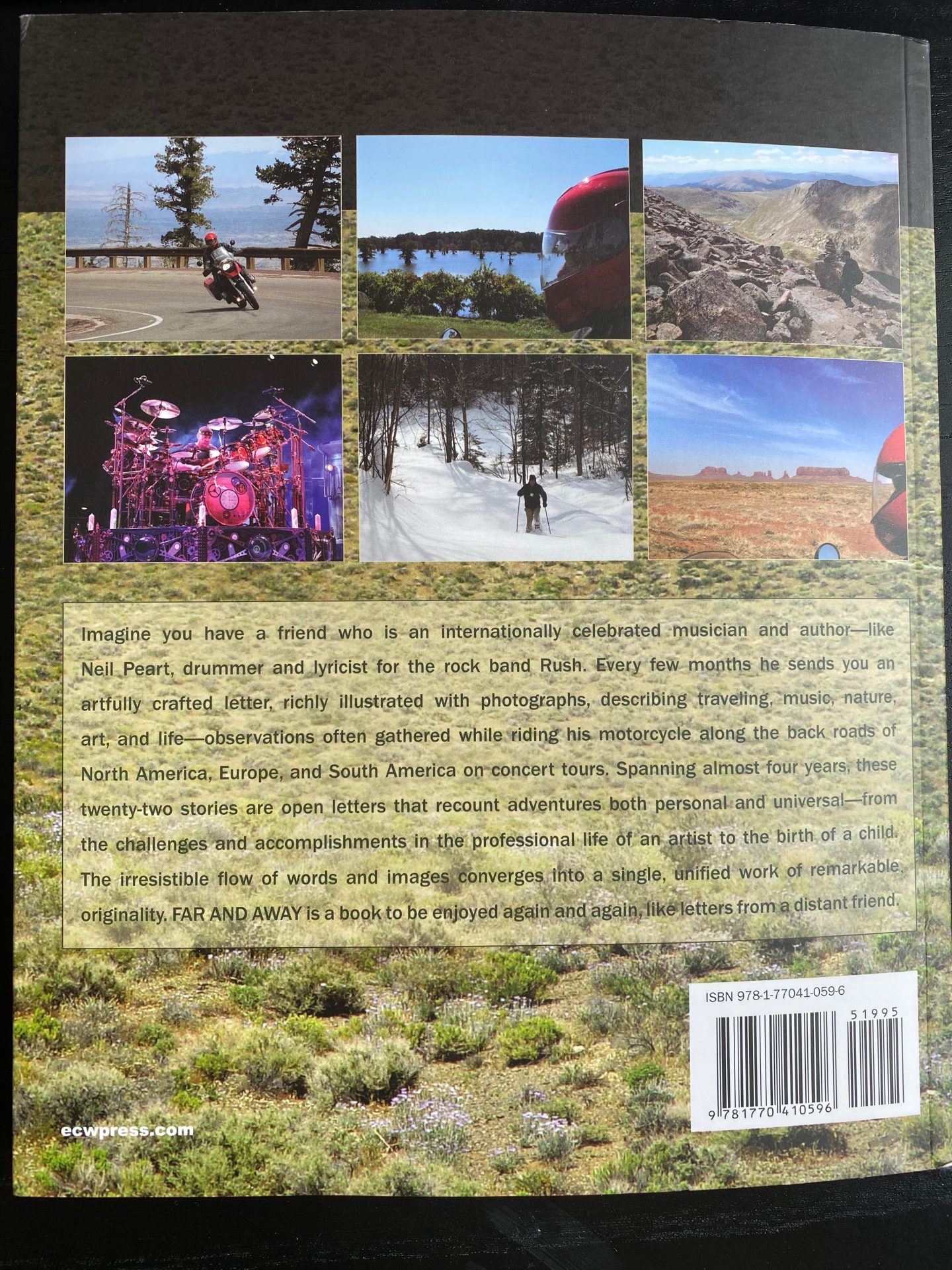
And this is one of the front cover fold-over and the interior – not coincidentally of the next chapter in this book!
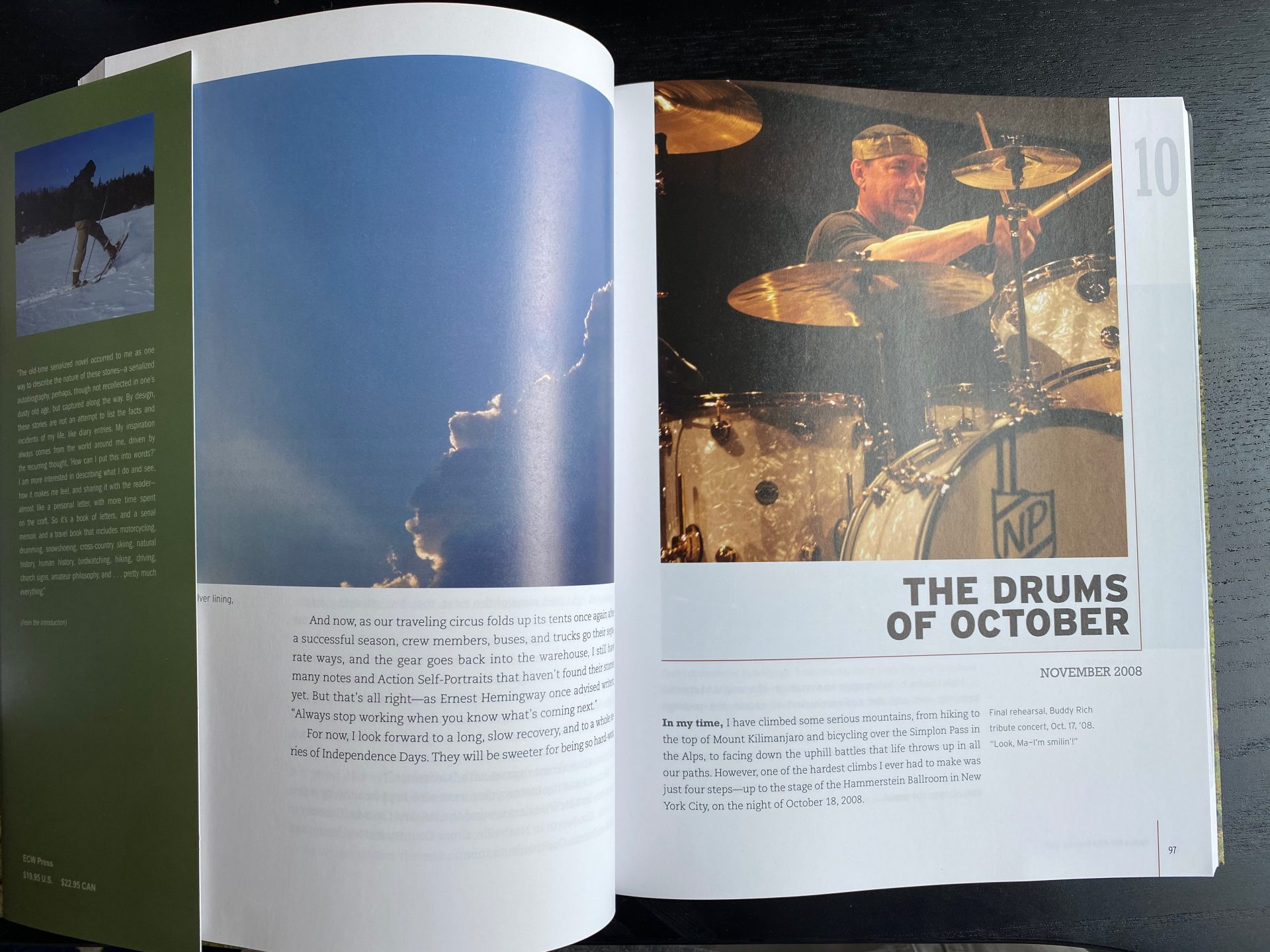
10. The Drums of October (November 2008) – Neil Peart at the Buddy Rich tribute
Yet another chapter that is not about motorcycling, but is about drumming! This long chapter goes through the lessons, practice and stories leading up to Neil playing at the Buddy Rich tribute October 18, 2008. There are a lot of great details in here about Neil taking drumming lessons again at the ripe old age of 56…it’s never too late to learn something!
One (of the many) pieces of history he mentions is an arrangement he did of YYZ for the Buddy Rich band. It’s a great rendition – video of it posted below.
11. December in Death Valley (December 2008)
This chapter documents a rare solo ride by Neil to Death Valley. There are lots of consistencies and re-occurring themes in these articles. This is to be expected from a man who understands the value of practice, of the journey and of consistency. One of these recurrences that I enjoy is the collection of National Park passport stamps in his journal (which he does for Death Valley National Park on page 111). I wonder how many he collected? According to this link as the beginning of 2021 there are 63 National Parks, and 423 national park sites (which include monuments, battlefields, historical sites, recreation areas, etc.). As with many, my family and I have visited several, and seen the traditional passport stamp by the cash register in the visitor’s center. I have not visited one since the pandemic began – did they somehow make them contactless? Their website still sells the blue national park passport books.
He also stops on Route 66 to recreate a photo he took a decade earlier for Ghost Rider. Neil’s writing evidences memorializing remembrances in several ways in several places. This place has several of those, as he talked about the line from the lyrics of Ghost Rider inspired by Telescope Peak in the park: “From the lowest low to the highest high.”
12. A Winter’s Tale of Summers Past (February 2009)
This chapter starts out again in Quebec for the winter, with lots of snow. But it meanders back to rides from the year before. And Neil mentions an encounter with “our friend Wes, guitarist from the excellent band Porcupine Tree (and a fine player and singer as a solo artist).” I started listening to Porcupine Tree when I found out that Alex Lifeson did a guest solo on one of their albums (Anesthetize, which is on the album Fear of a Blank Planet). The circle is complete!
There’s also a great exchange that Neil documented with his wife – I’ll let it speak for itself.
After I cleaned up and got myself organized, I called my wife Carrie and told her about our adventures, and how exhausted I was from traveling.
Now … in this reporter’s experience, a woman rarely misses an opportunity to try to teach a man a little humility, and Carrie just said, “Well, you didn’t have to do all that.”
Taken aback, I thought for a moment, then blustered, “Sure I did!”
It seemed obvious to me. I had to work in Tampa Saturday night, then in Raleigh on Monday. So looking at that day between, I could only think, “What’s the most excellent thing I can do?” If I settled for something less than that, I just wouldn’t feel good about myself, or about how I had spent my day.
pages 135-136
13. The Quest for the Phantom Tower (March 2009)
When I initially read the title of this chapter, I was sure it was going to be about the Lord of the Rings. It does indeed involve a tower with red at the top, and quests. And, just to get my geek level revved up, Neil does mention “the Eye of Sauron in The Lord of the Rings.”
Someone has put up a new tower with a red light on it that can be seen from Neil’s cabin in Quebec. He and a friend set out on a quest (which ends up being three quests) to hike/ snow shoe to it. There is a great photo at the end of Neil shaking his fist at the hated tower.
14. Under the Marine Layer (June 2009)
This chapter describes a trip out to the Channel Islands National Park, one of the few Neil had never been to (and it is not mentioned if he got his passport!). It makes me wonder if he had ever been to Alaska, and all of the national parks there. I’d like to see a copy of Neil’s National Parks passport booklet or the journal where he got all of his stamps.
The “marine layer” refers to the layer of fog and wetness along the coast in Southern California that can be experienced in certain months. Neil also mentions the impending birth of his daughter.
15. A Little Yellow Cabin on Yellowstone Lake (August 2009)
Neil has five days off and takes a long long solo ride from his home in Southern Cali to stay at Yellowstone National Park, and see the bison, the geysers, etc.
My first journal entry, after noting the location and mileage, was, “Every detail I think of putting down seems inconsequential, yet it is the sum of those details that made the day.” Well ain’t that the truth.
page 171
When writing some of my articles, whether travel, historical or otherwise, I feel that motivation (or pain) to not leave anything out. I’ll forget those details years later (which is one main reason I write), and I cannot predict who may read them or what they come looking for. Details are important, and additive.
There is an aside in this chapter on the song Manhattan Project, as Neil rides through a town with connections to the nuclear projects. That city is Arco, Idaho – the first community in the world every to be lit by electricity solely generated by nuclear power. These are the kind of details that do indeed make the story – and make some readers go down internet rabbit holes (guilty!).
16. The Ballad of Larry and Suzy (September 2009)
I was very happy to see my name mentioned in Neil’s book (even though we never met, but I have met Ged!), but who the heck is Suzy? Turns out these are the names given to two hatched hummingbirds in a nest in Neil’s backyard. His anxiety for them mirrors his anxiety and his worries about his wife and his soon-to-be-born daughter. His tone is more hopeful, though he does harken back to the dark days of past tragedies.
Olivia Louis Peart was born August 12, 2009, healthy, safe and sound.
On September 12 of 2009, Neil Peart turned 57.
17. Autumn Serenade (November 2009)
Yay! A drum chapter! And it is Neil describing playing the drums “for the pure enjoyment of it”. He talks about listening to great drummers making him want to go play, and specifically mentions Parallel Realities by Jack DeJohnette. So, of course, I put that album playing in the background to read the rest of this chapter.
18. Fire on Ice (February 2010)
What could be better that a chapter about hockey by a Canadian drummer? Only one thing – the photo on page 213 of Neil holding The Stanley Cup behind a drum kit with NHL team logos on them! As a LARGE San Jose Sharks fan (thanks to Bob and Nani-Jay) I looked closely at every photo trying to find the Sharks logo!
Neil was recording “The Hockey Theme”, Canada’ second national anthem, for the CBC Network. Neil and his family became Chicago Blackhawks fans, as the team they watched, St. Catherines Blackhawks, became a farm team of the Blackhawks NHL team.
19. Time Machines (May 2010)
This chapter starts with a photo of Neil in a band called J.R. Flood when he was seventeen. There’s a lot of good history in this chapter that has been reported elsewhere, but there’s a photo of Neil’s view of his 1964 Aston Martin DB5. The theme is reflection on the past and the present.
20. Theme and Variations (August 2010)
Like the book we wish he would have written that he mentioned in chapter 9, this is about Neil’s road craft. Preparation allows for improvisation and spontaneity, with travel as with drum solos. And he writes some comments about how peaceful parts of both are – the smaller emptier back roads, and the low pressure drum practice before a show. I’ve called those moments of zen, or moments of flow, or moments where time actually does stand still. Searching for those moments is a worthwhile life-long quest.
21. Cruel Summer (September 2010)
On September 12 of 2010, Neil Peart turned 58.
In this chapter, anything that could go wrong did go wrong. Bus problems, weather problems, motorcycle mechanical problems. But Neil did get to hike up his first Colorado 14er with author Kevin J. Anderson (who would later co-author the Clockwork Angels novel with Neil, a novel I was privileged to review for SFSignal.com back in the day). As a side note, Kevin continues to write in the Clockwork Angels world. These and all of his works can be found on his web site.
The chapter ends on somewhat of a sad note, where Neil is in a beautiful place but homesick, and feels worse after calling home than he did before. With a less than one year old at home, I can imagine. I felt that, with the business traveling I’ve done, where you’d rather be out with the ones you love or at home with them; sometimes the exotic and far away places aren’t that magical without your soulmates with you.
22. The Power of Magical Thinking (November 2010)
If I think I can do a motorcycle tour across parts of South America while the band is touring, then I can! This is the Neil Peart definition of the power of magical thinking. They set off on an epic trip, do indeed get lost, take an interesting ferry ride, are met at country borders by law enforcement who escort them to their gigs, and generally have a great time.
As I stated at the outset, I believe that everybody has their own version of magical thinking. My own “dream, dare, hope” approach to life is not based on reason; it’s a kind of faith – that I will be able to accomplish something about which I dare to dream. I once called it “Tryism,” believing that if I tried hard enough at something, it would eventually yield and come to pass. The fact that such an approach sometimes works is no empirical proof of its truth, per se.
page 281
This is a great sentiment with which to end this book and move on to the next.
Outro: The Prize
Per Neil Peart, the meaning of life is: love and respect. As soon as I read this final section, I went to look for a certain Rush song (which I do frequently). Neil came back to this in the lyrics to the song The Garden on the Clockwork Angels album.
The measure of a life is a measure of love and respect
So hard to earn, so easily burned
In the fullness of time
A garden to nurture and protect
Neil Peart, The Garden



